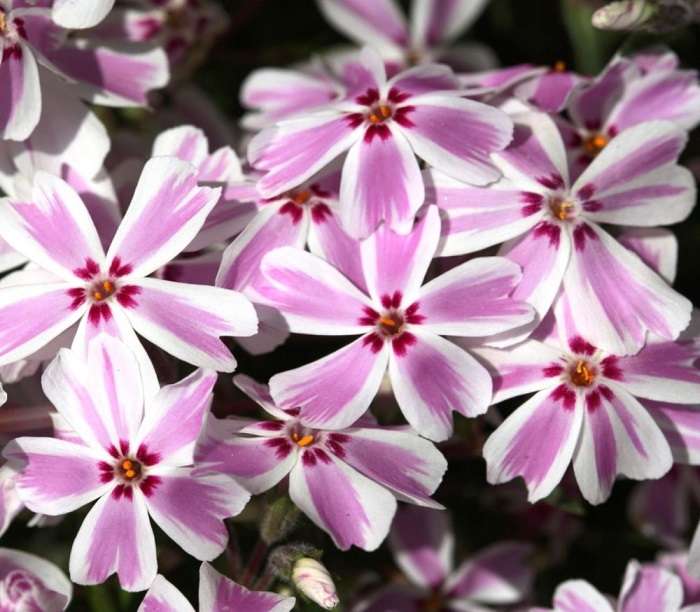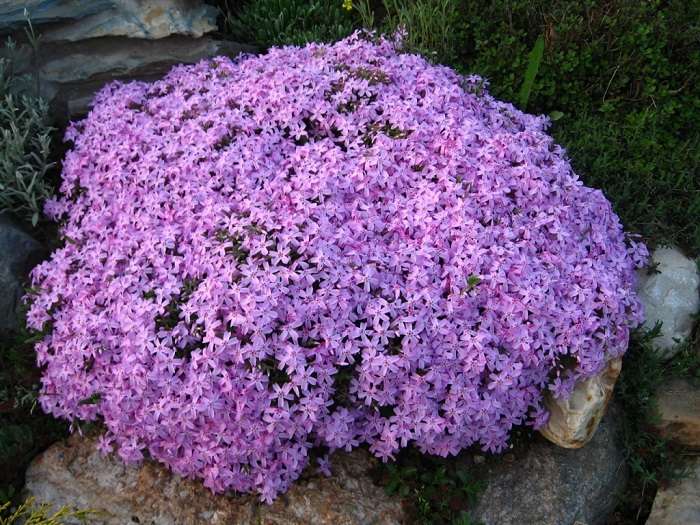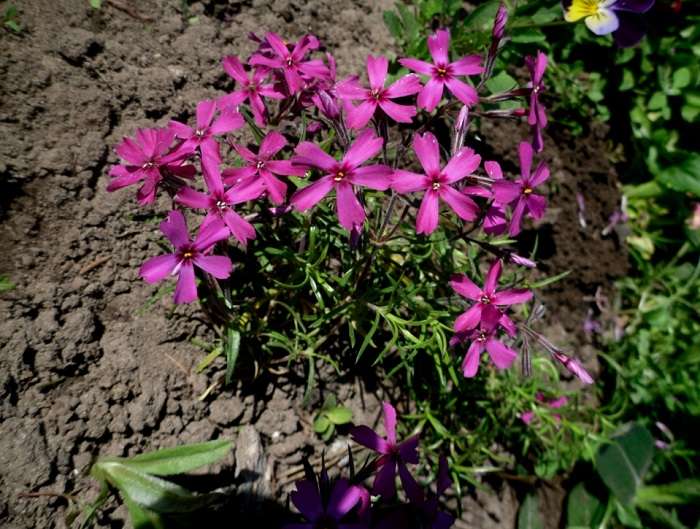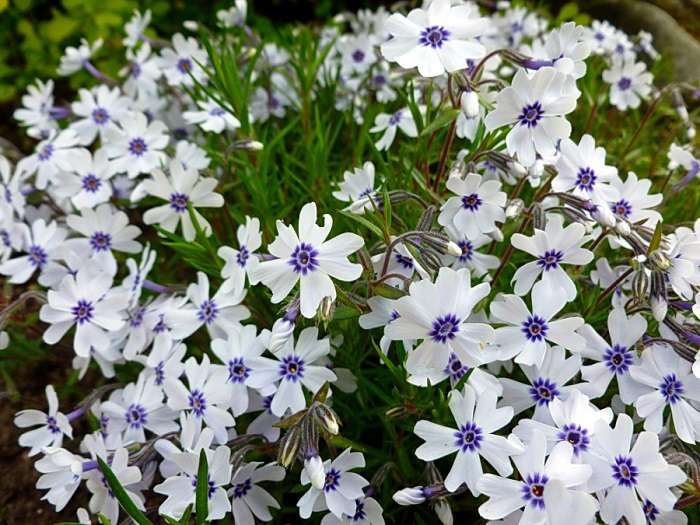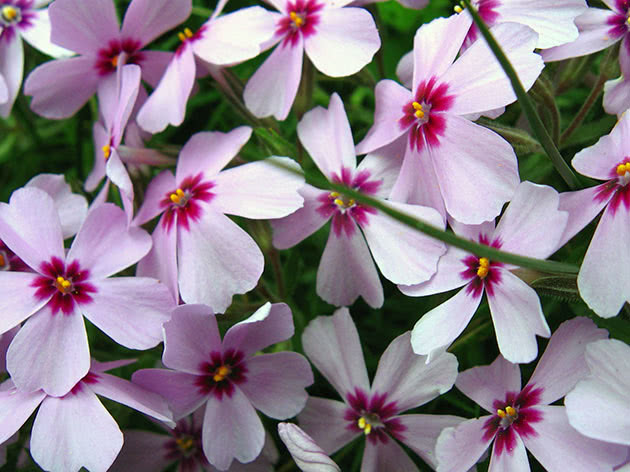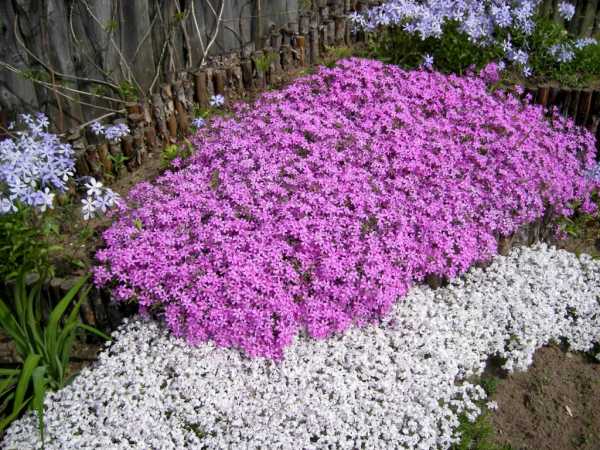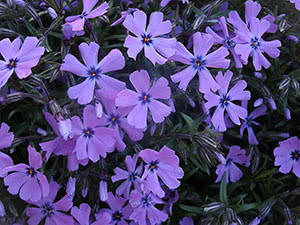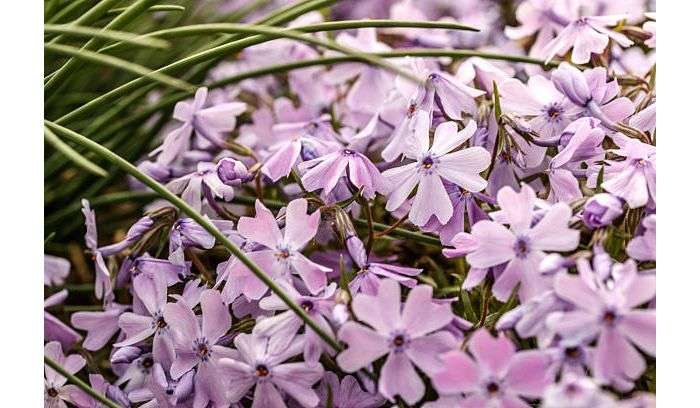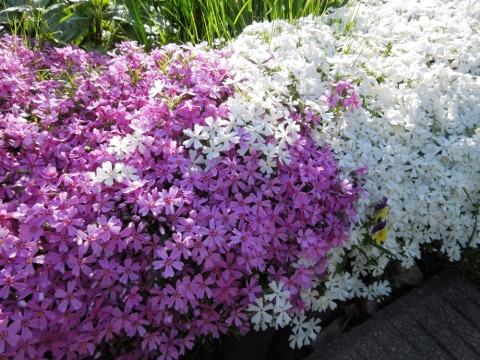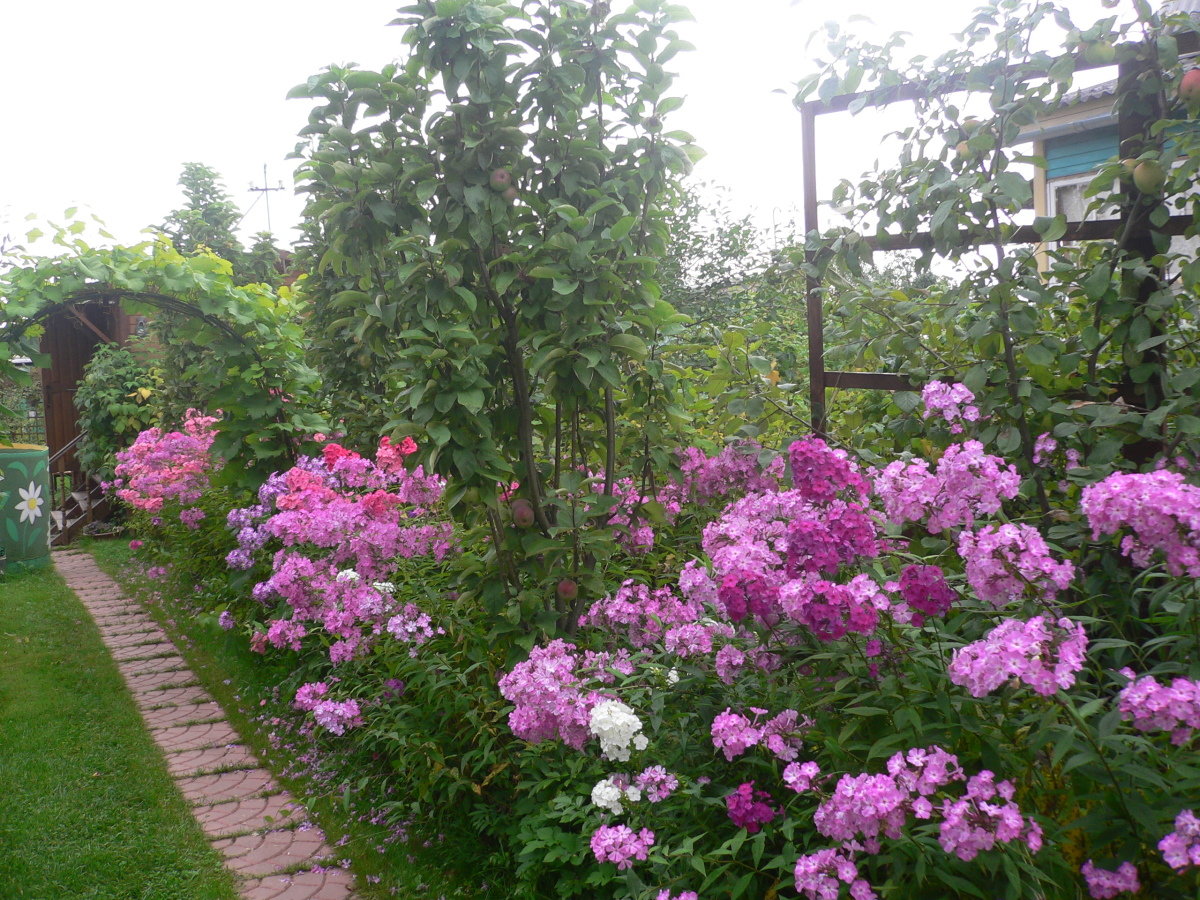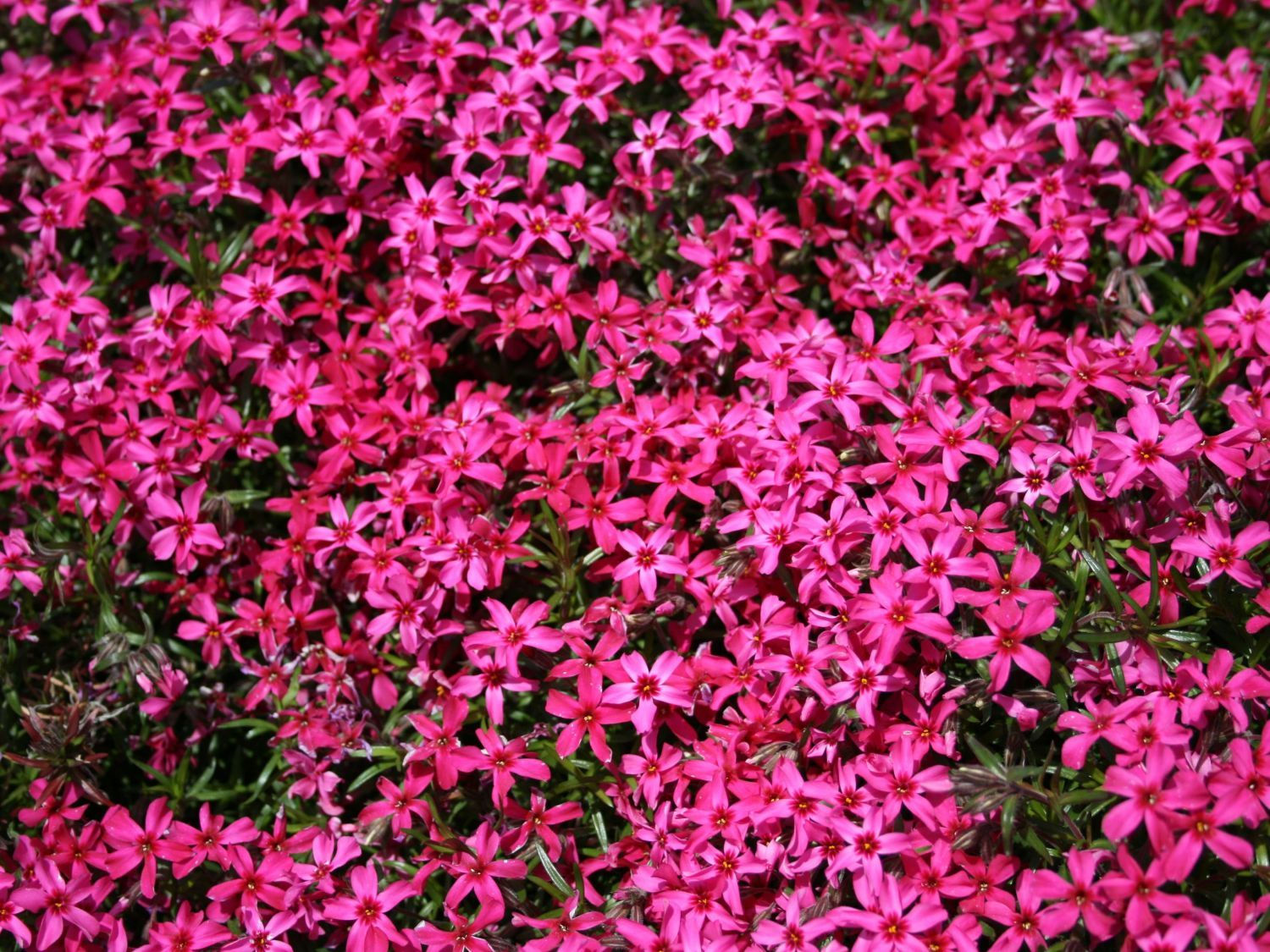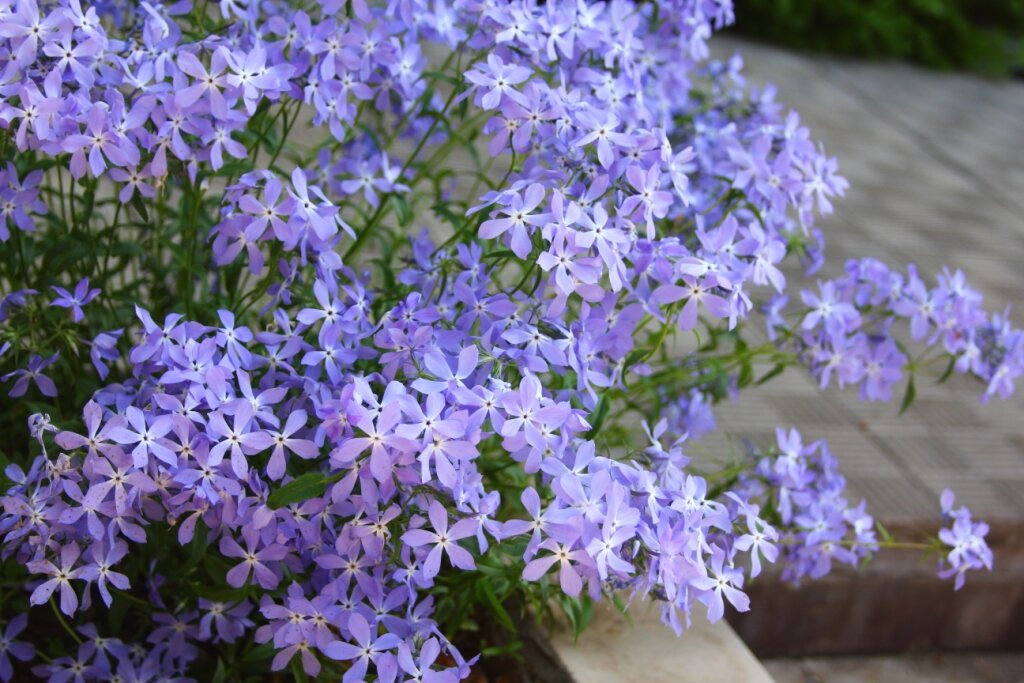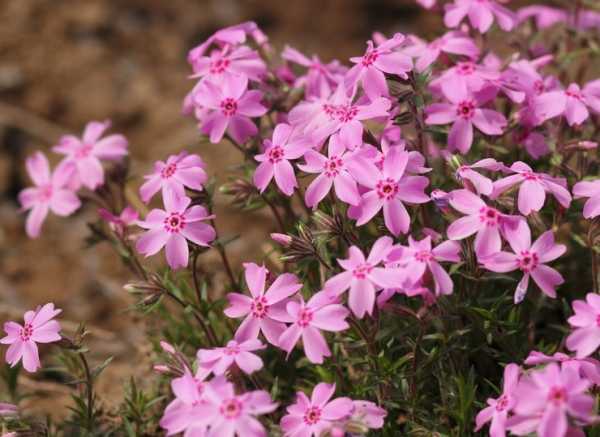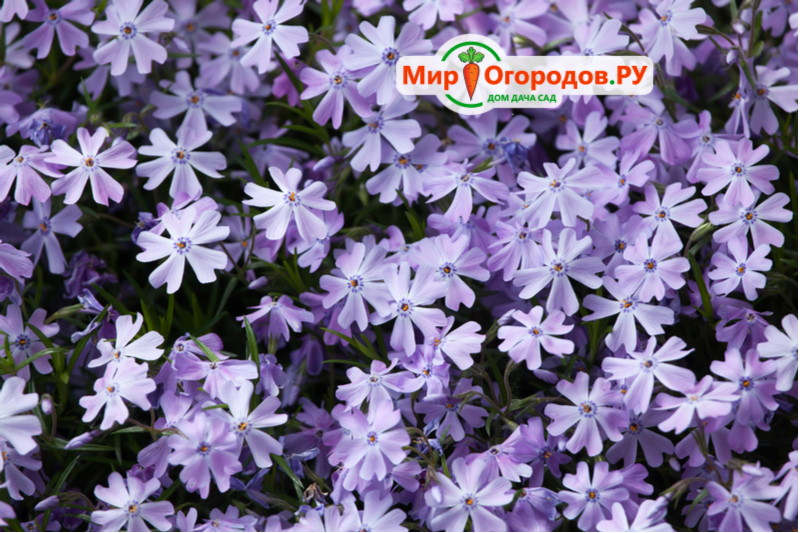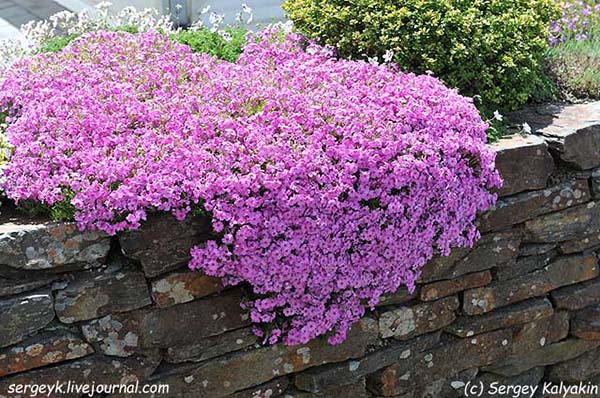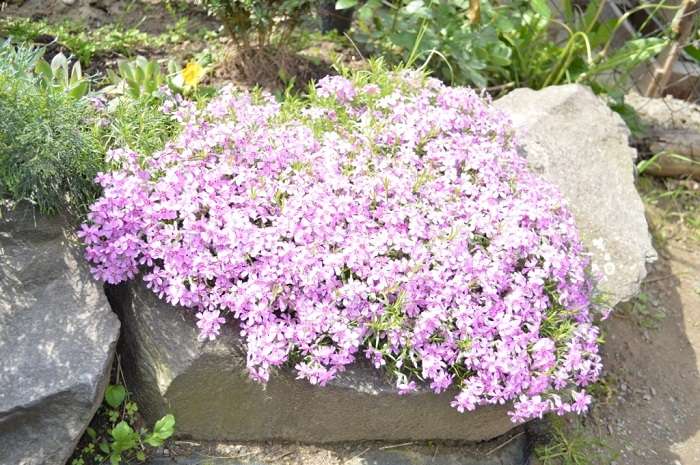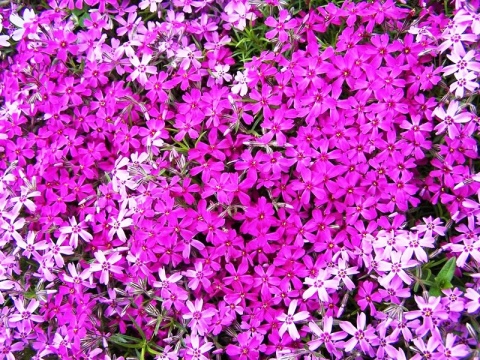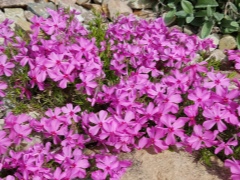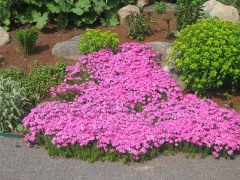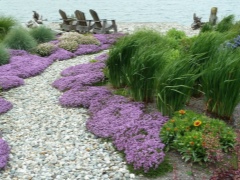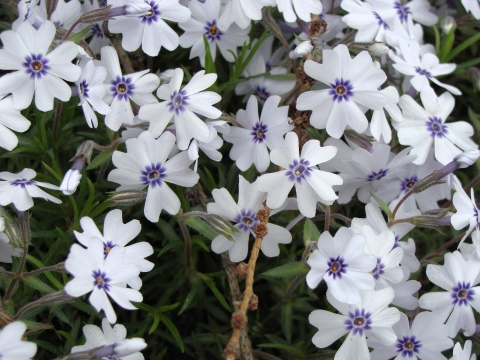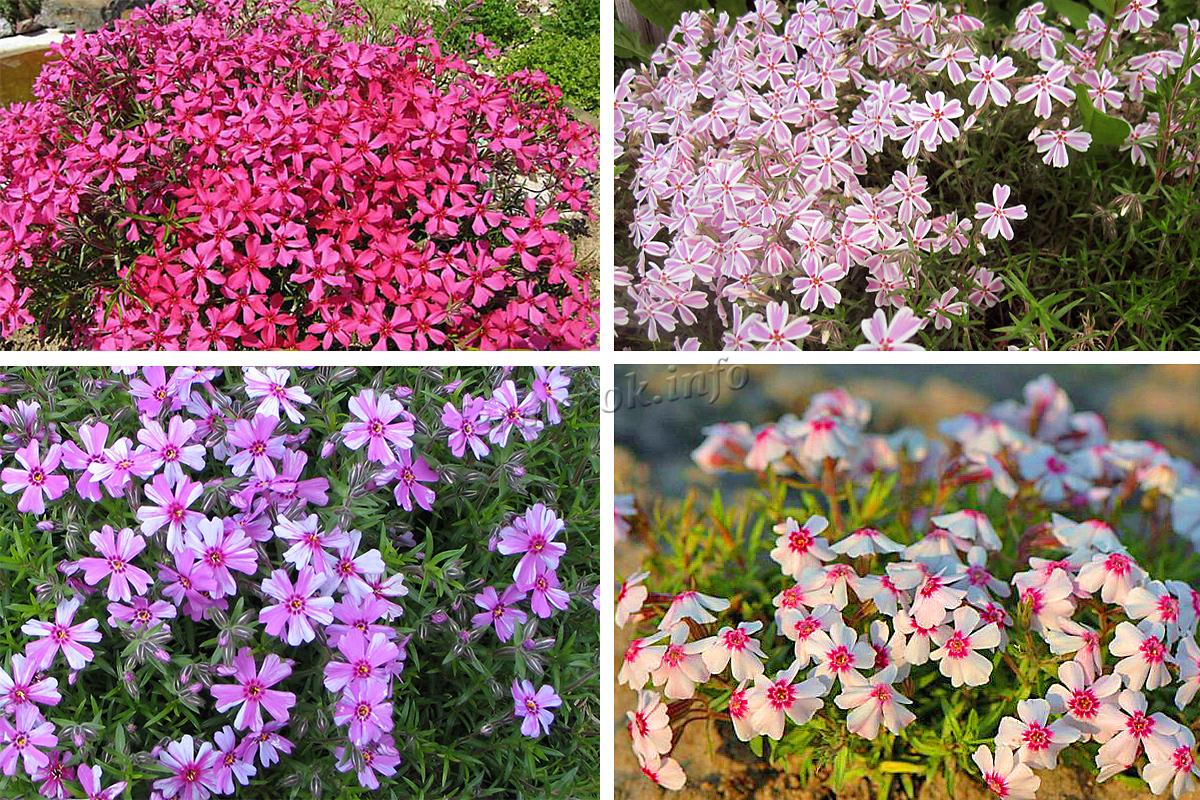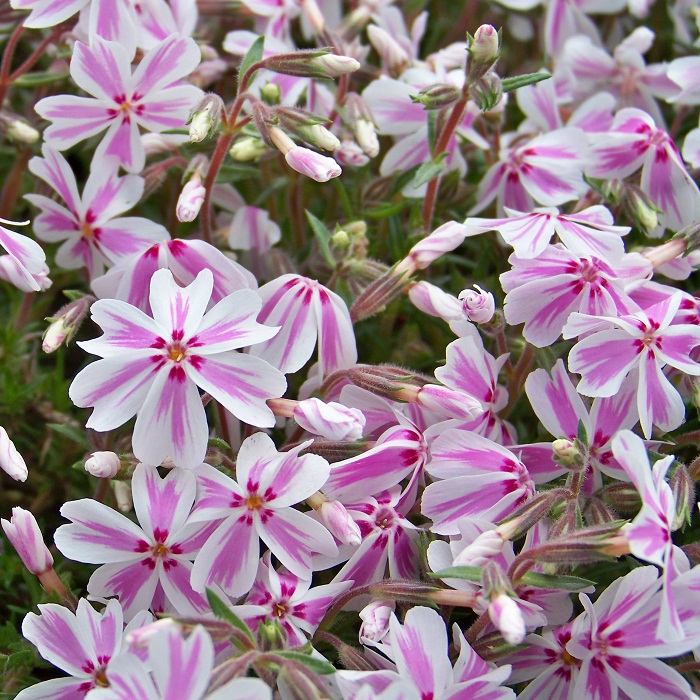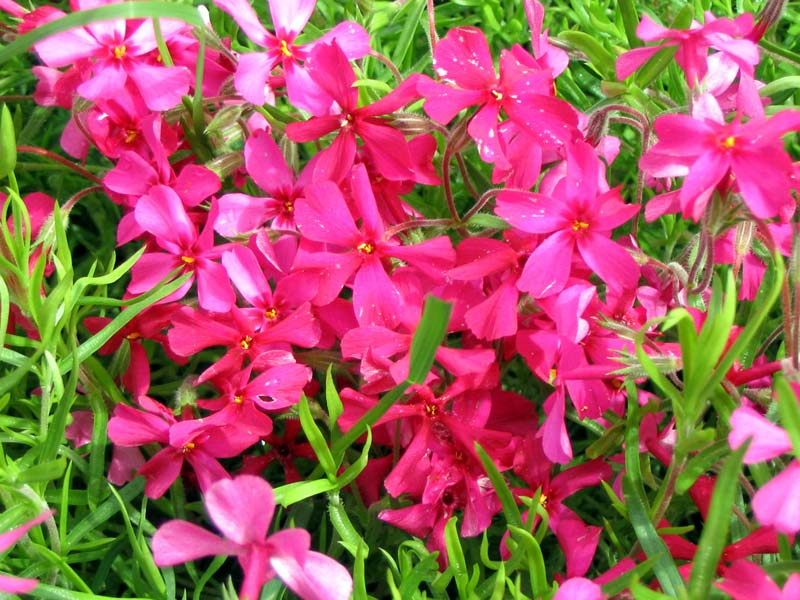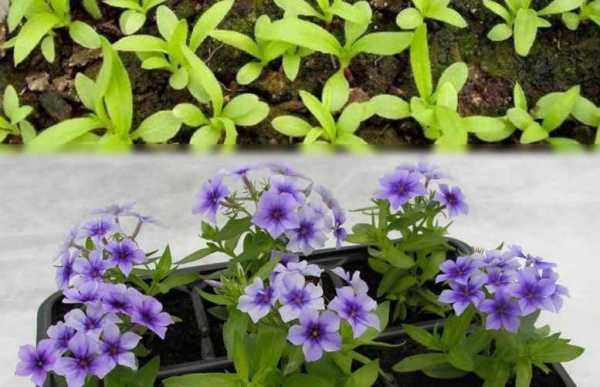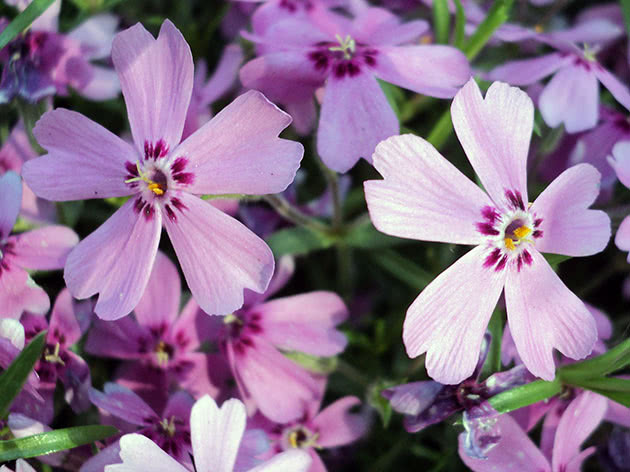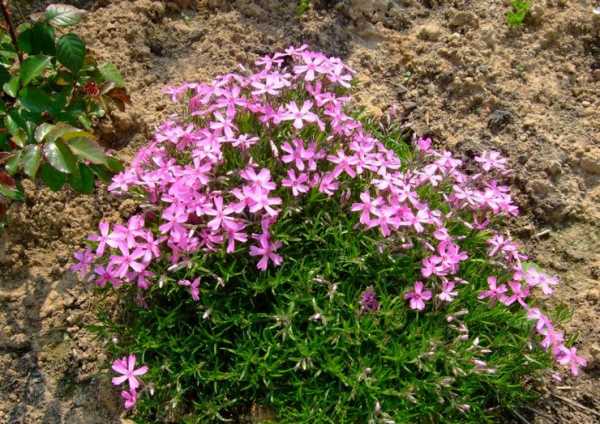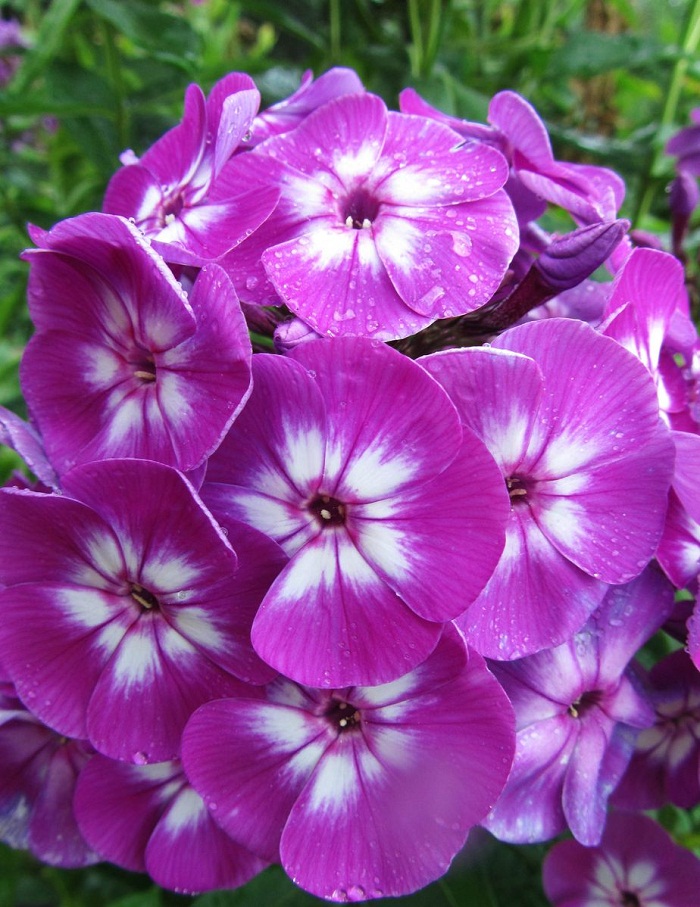Agrotechnics. Phlox subulate
Planning a flower bed
 rough plan
rough plan
To make the site look aesthetically pleasing and tasteful, it is better to plan in advance what and where to plant. Ground cover plants can be planted next to a reservoir, diluting the greens, which are also needed there. Saturated shades of red and purple look very beautiful against the background of natural stones, undersized conifers. White phlox is best combined with burgundy, lavender. It should be taken into account that the plants grow strongly and leave an empty space in the flower bed in advance. You can see examples of how you can arrange a site with subulate phlox in the photo in our article.
Now, with regards to important conditions. Phloxes do not like excess water in the place where they grow. Plants immediately lose their decorative effect, bald spots appear, the shade of flowers fades. It is best if the earth is loose, there is a lot of sun in this place. It is also better to remove malicious weeds in advance, since during weeding they will be pulled out together with the surface roots of phlox.
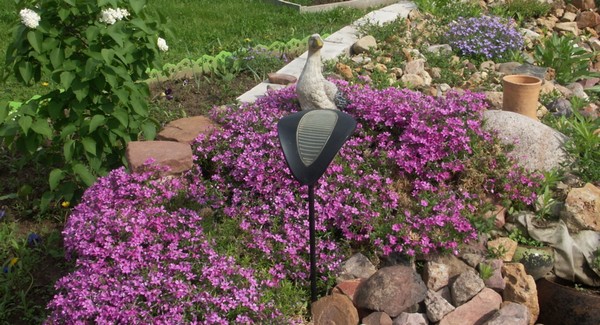 beautiful decor
beautiful decor
Choosing the timing
Seeds of subulate phlox can be sown on the site both in spring and before winter - they will undergo stratification and germination will be maximum. The shoots, if you do not grow flowers from seeds, can be planted both in the spring and in the fall. But the second option is even preferable, since the seedlings will take root in September and October and will bloom two weeks earlier in May.
Preparing the soil and planting flowers
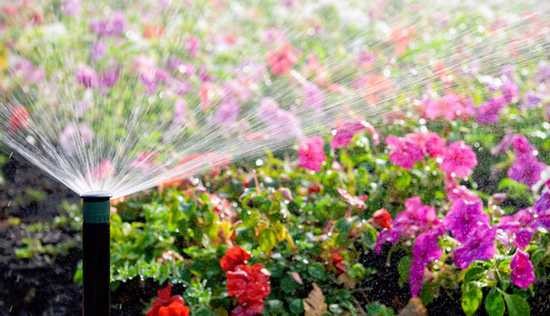
Let us first analyze the method of preparing the soil and planting phlox, which are grown from ready-made seedlings. The place for them must be freed from plant debris. If the soil is heavy, difficult to weed or loosen, then add sand until the soil becomes crumbly. Neutral soil for phlox is best suited, if you have acidity, then add a glass of slaked lime per square meter.
If you are sowing seeds, then the correct technique is done by stratifying the seeds. In the fall, you should prepare the soil with humus, garden soil, and sand. Place it in a container, moisten it slightly and sow seeds at a distance of 5 cm from each other. This is done at the end of November-December. Further, the crops are taken out into the street and covered with a high layer of snow. In March, sprouts will begin to hatch, now they need to be brought into the greenhouse or onto the balcony, watered as needed. At the end of April, phloxes are planted in a permanent place in holes with humus and sand.
Care of styloid phlox
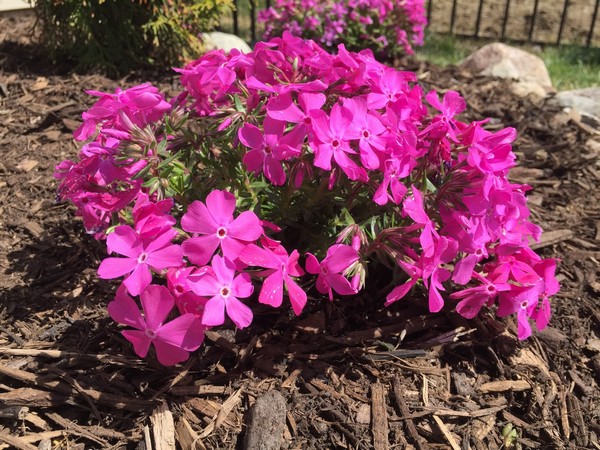
They landed, what now? Yes, everything is simple, because flowers require a minimum of attention. When they begin to sprout, they need watering so that the soil does not dry out, but at the same time it is not wet. It is immediately necessary to remove weeds, loosen the soil very carefully, since the roots are on the surface. Surprisingly, phlox may never start blooming, but only produce greens if the soil is full of nutrients. 1-2 phosphorus-based feedings are enough for them, you can buy a complex liquid feed for flowering. Water before flowering or during and after flowering.
A subulate phlox is very easy to dilute. It propagates by seed, you already understood how to plant. You can also split the root or take cuttings. This is done in the spring, fall, and even summer. While digging, simply separate a part of the root and plant it in a new place, or cut off the stems, put them in water, where you can add "Epin", "Kornevin". They also shed seedlings that were separated by the root, so they take root faster.
When the cuttings are rooted, you can plant them already on the site. Less often, subulate phlox are bred by dividing the leaf.To do this, tear off the leaves together with the stalk and place them in the nutrient soil at an angle, cover them with a film on top. When the seedlings have taken root, they are transferred to a permanent place.
That's all you need to know if you want to plant styloid phlox. In fact, everything is simple, you will be surprised how unpretentious and beautiful they are.
- the plant is not capricious. It takes root in different soils and does not require special growing conditions, therefore it successfully adapts to different situations. But still, in order for his charming to please for a long time, phlox needs to create optimal conditions. Which ones - we will tell you in detail.
Types and varieties of subulate phlox: photo
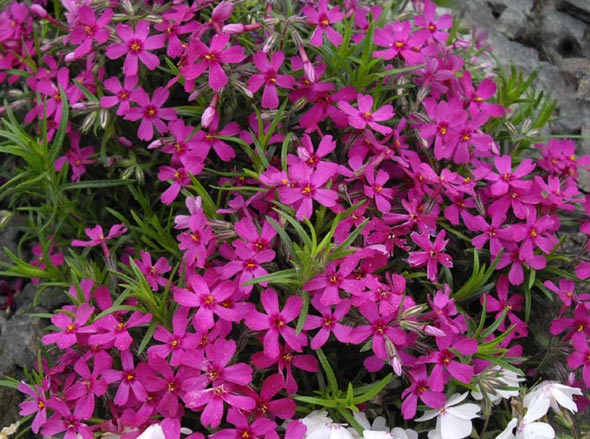
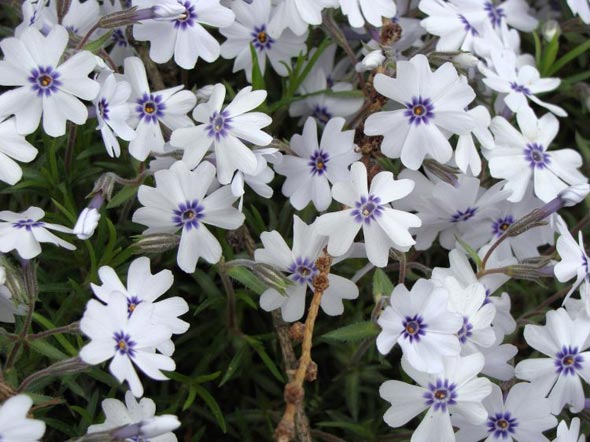
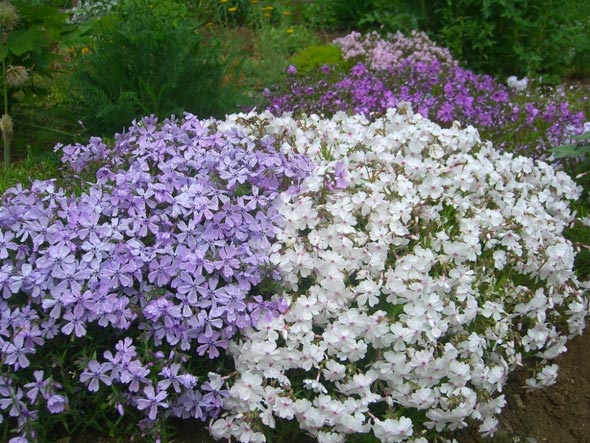
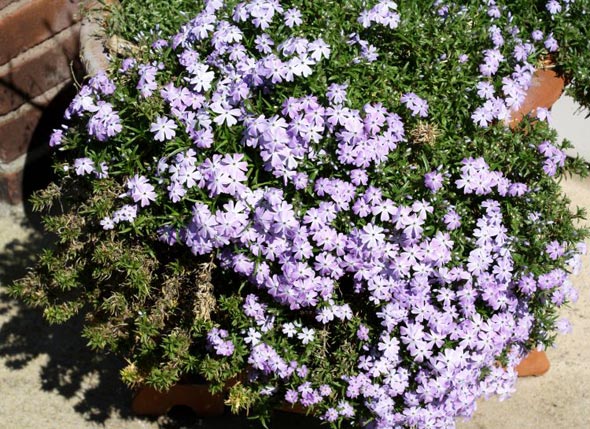
To create on your site not an ordinary flower garden, but real lakes or a thick carpet of flowers is a very real task if subulate phlox is taken for its implementation.
Phlox subulate / phlox subulata.
Phlox is a plant belonging to the ground cover perennial shrubs of the Sinyukov family.
Basic information about the plant:
- Height: from 15 to 17 cm, there are miniature plants from 5 cm in height, as well as varieties up to 21 cm in height;
- Stem: creeping (lying), green, hard. During the development of the plant, the stem can reach 0.5 m in length. The stem consists of many internodes, which, when in moist soil, often release additional roots. Leaves grow along the entire length on the stems, which are at a short distance from each other.
- Leaves: evergreen, opposite, small (1-2 cm long), narrow, very tough, with a pointed tip. The shape of the leaf, resembling an awl, gave the name to the plant.
- Flowers: small (up to 2 cm in diameter), consist of 5 petals. At the base, they are connected and a tube. When opened, the petals form a flat corolla. The petals are of different colors (white, cream, pink, bright red, blue, etc.), two-color phloxes are often found. During flowering, they exude a delicate aroma.
- Root system: fibrous, consists of many adventitious roots. The depth is up to 15 cm.
- Flowering time: late May - early June. A second flowering period is possible - September.
- Names: The Latin name for phlox subulata is phlox subulata. People also call it creeping, carpet, and also moss carnation.
Description of the plant
The tallest plants reach a length of 1 meter, but more often you can find small phloxes. Plants love to use in design. Phlox flowers of various shades - purple, red, blue, white. It usually blooms in spring, slightly capturing the summer period. The leaves are small, shaped like an awl. The plant has a lot of leaves and flowers.
In this article, we will consider the most popular types and varieties of plants:
- Candy Straps - very long flowering, many flowers, white with pink stripes. The plant is only about 10 centimeters long.
- Emerald Kushon Blue - purple flowers, smell delicious. Blooms for a long time.
- Emerald Pink - very beautiful pink flowers.
- Scarlet Flame - up to 15 centimeters long, bright pink flowers.
Phlox subulate does not require any special care. It can be without water for a long time, it tolerates drought well. In hot weather, water the plants a couple of times a week. If there is no heat, once every 7 days is enough. If it suddenly happened that the flowers remained for some time without watering, do not worry. Nothing bad will happen. The plant accumulates water in itself for such cases. Be guided by the ground, a dry top layer of soil means the plant needs water. If you have just planted a plant, regular watering is required.
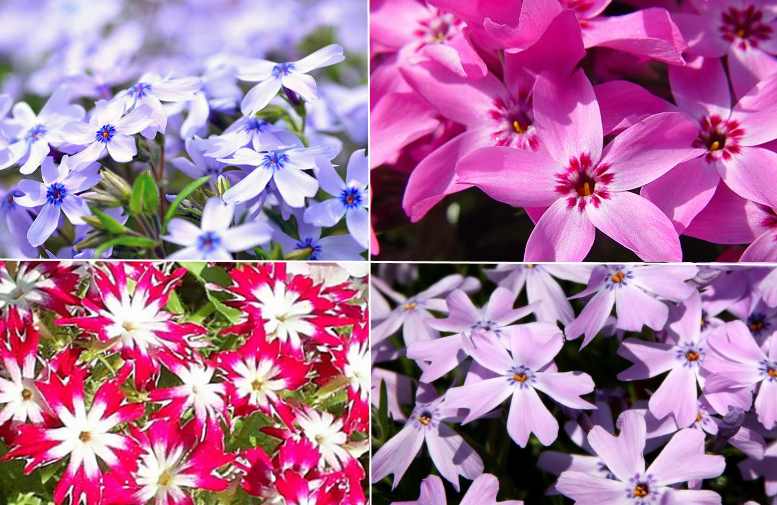
Phloxes love light and warmth. Plant in a sunny area. Be sure to remove weeds, they interfere with the growth and development of the plant. Fertilize the soil several times a year. At the beginning before flowering, then during and after flowering. Most often, gardeners fertilize the soil with liquid manure.Special fertilizers are also used. You can get them at the flower shop.
You can shape the bushes yourself. Pruning is best done in the spring. Removing dried leaves and flowers stimulates the phlox to bloom again.
Mattiola two-legged landing
- Sowing seeds is carried out in early February. You can sow in March, but then the flowering time will be different.
- Sowing should be carried out on prepared soil with a distance of 4 centimeters from each other. The seeds do not need to be pressed into the ground, just sprinkle them lightly with earth. Next, you need to gently pour water at room temperature and cover with a film or glass.
- Seed containers should be placed in a well-lit place. Do not water until the first shoots appear.
In order for the seedlings to grow well, certain conditions must be observed. As soon as the first shoots appear, it is necessary to provide the plant with good lighting, and the air temperature should drop to +12 degrees, otherwise the seedlings will begin to stretch.
If the cultivation of seedlings takes place in seedling boxes, then a dive should be carried out every 14 days.
It is important to remember that Matthiol has a very fragile root system, so when transplanting, the seedlings will die, no matter how careful you are.
A well-moistened soil into which you plan to transplant will help protect the roots from damage. You need to get the plant one by one, protecting its fragile roots. Before this, it is necessary to make planting holes in a new container, into which the seedlings are transplanted. Next, they must be covered with a layer of earth to the leaves, gently, with fingertips, tamped around each plant and watered well.
Gardeners with experience in growing matthiola do not pick seedlings. For growing without picking, you can use a box where eggs or chocolates were stored before. These cells are filled with soil and 3 seeds are planted there each. When they all grow up, you can choose the strongest, and remove the rest.
Transplanting a flower to the place where the plant will grow constantly is carried out together with an earthen clod and with the onset of constantly warm weather. It is best to hold these events in the last days of spring or in the first days of summer.
When planting, it is important to leave a distance of 20 centimeters or a little more between the plants, it depends on which varieties are planted. For better adaptation and faster rooting, the young plant needs to create a shade.
Gardening rules:
First of all, it is necessary to cultivate the land with the help of manganese. Next, loosen and form furrows, the depth of which will not exceed 50 mm. If the distance is deeper, then the sprouts will not be able to appear above the surface of the ground.
In order for the seeds to be evenly distributed, they must be mixed together with sand in equal proportions and scattered along the furrows.
Then they must be sprinkled with 50 mm. a layer of earth. In this case, tamping is not required, it is necessary to lightly spray with water.
A flower planted in February can please with its colors and aroma already at the very beginning of summer.
Seat selection:
Mattiola loves to grow in open sunny areas, in the shade it will stretch and take on a painful appearance. The site must be protected from strong winds. If you follow all these simple rules, then in a short time you can enjoy the magnificent aroma of flower tassels.
The flower prefers loose and fertile soil, but it is not recommended to apply organic fertilizers in the form of a mullein due to the content of phytophthora spores in it. Loamy and sandy loam soils are a good option. The acidity level in the soil should be neutral.
You should not choose an area where plants belonging to the cruciferous family were previously grown.This legacy is often dangerous, and the flowers can contract diseases such as keela and fungal infections.
Site preparation for planting is carried out in the autumn. The earth must be dug into the depth of 50 centimeters and at the same time add cow dung. Thanks to the digging, it is possible to destroy the spores of the fungus in the ground and prevent the further development of the black leg.
Landing
You can propagate a perennial "chamomile" by dividing an adult bush into several parts, which is done when transplanting to a new place. Another method that flower growers practice is seed propagation. In rare cases, cuttings are used.
Growing from seeds
Seeds ripened in September can be harvested from specimens of the most interesting color and shape.
But there is one "but" here. Hybrid seed collection forms cannot be used. The bush will grow weak and the flowers will be faded, so the seeds should be purchased from the garden center.
If the dried flowers are not removed during the season, then the seeds ripened in them will self-sow and in the spring numerous shoots of young plants with weaker varietal qualities will appear on your site. It is desirable to remove them.
The seed sowing sequence is as follows:
- Containers, boxes or other containers are filled with earth, which must be well moistened.
- Sowing is carried out in February-March superficially: the ground is lightly sprinkled with vermiculite. They try to spread the seeds evenly over the surface.
- The containers are placed in a bright room at t = + 20-23C, periodically moistening the soil. Cover with glass or foil to create a greenhouse effect.
- Shoots appear after 2 weeks, which are covered from direct sunlight or transferred to a cooler place. A greenhouse with high humidity and moderate temperatures is suitable.
- Seedlings dive in the 3-leaf phase into separate cups, provide moderate watering and light for 14 hours.
The duration of daylight is long, so it is advisable to install fluorescent lamps. In low light and high humidity, small seedlings can develop gray rot.
Planting seedlings in the ground
Usually, flower growers practice autumn sowing, when the seedlings grow large and strong enough. Planting time is from mid-August to mid-September. A place for a bright plant is selected sunny with nutritious and light soil and (if necessary) a drainage system.
Small plants, obtained from seeds and ready for planting in the ground
The soil is carefully dug up and applied to 1 sq. M. a bucket of compost or humus, a glass of wood ash and complex mineral fertilizers in a minimum concentration. Gaillardia does not like excess moisture, acidic soils; fresh manure is not suitable for her as a fertilizer.
Seedlings are planted in holes at a distance of 30-40 cm. For undersized and compact bushes, this distance is reduced to 20-25 cm. The planting site is compacted and watered abundantly, shading from the bright sun. In the garden, they are planted in separate groups of 3-5 pieces, which look like bright color spots.
Planting period and rooting process
Plants adapt well and take root until the winter, and the next year they begin to bloom. Sometimes flower growers practice spring sowing of seedlings. The seeds are planted at a distance of 1-2 cm so that they grow stronger and form a rosette of leaves. In autumn, young plants are transplanted to a permanent place, and the next year you can admire the bright colors.
Sometimes seeds are sown directly into the ground from July to September. They are scattered superficially, without embedding deep into the soil. In spring, a rosette of leaves begins to form, and flowering begins only after a year.
Young seedlings planted in the fall should be cut "at the root" before wintering, removing the entire leaf part. Then cover with dry foliage or spruce branches, since delicate shoots can freeze out.
Forsythia: description, planting in the open field, departure from the Moscow region to Siberia - mini-encyclopedia (80+ Photos & Videos) + Reviews
Protection against diseases and pests
Most often phloxes suffer from variegation and powdery mildew. In the first case, an ugly pattern, unusual for a plant, appears on the leaves, in the second - a white matte bloom. Prevention of these diseases - spring treatment with Bordeaux liquid. If you notice symptoms, remove the damaged plants.
Also among phlox diseases there are:
- septoria (signs: brown spots on the leaves);
- phomosis (signs: fragility of shoots, drying of leaves).
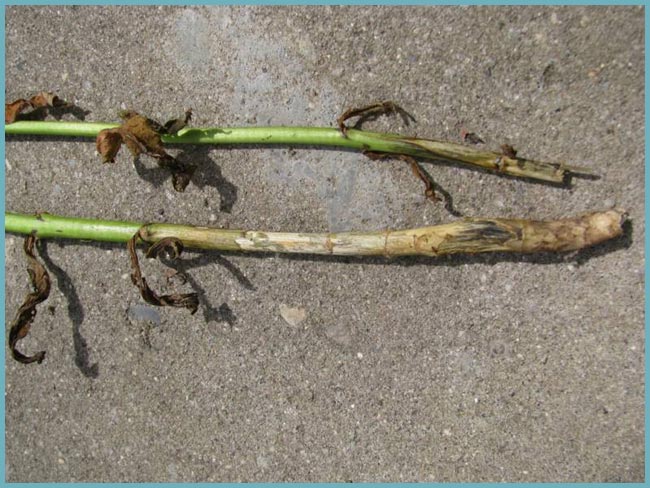
Phlox shoots infected with phomosis
If symptoms of septoria appear, spray the bushes and soil near them with Bordeaux liquid. Do the reprocessing after 14 days. The development of phomosis is easier to prevent by spraying phlox with colloidal sulfur.
Attention! The air temperature during processing should be at least + 18 ° C. Of the pests, phlox are most annoyed by nematodes and other filamentous worms.
If they settle on plants, the stems become brittle, the leaves and flowers are deformed. Affected phloxes must be dug up and burned, and the soil must be treated with nematicides
Of the pests, phloxes are most annoyed by nematodes and other filamentous worms. If they settle on plants, the stems become brittle, the leaves and flowers are deformed. Affected phloxes must be dug up and burned, and the soil must be treated with nematicides.
Heirantus in landscape design
Most often, heirantus is used for group planting in a flower bed. Beautiful inflorescences of warm colors look very impressive, while they cheer you up.
Such flowers also look great in mixborders, rocky gardens, rabatki and rock gardens. For planting low-growing varieties of heirantus, baskets, containers or flower pots are often chosen. They can decorate a balcony, veranda or gazebo.
When growing jaundice in a flower bed next to it, it is recommended to plant heliopsis, tulips, linaria, Vittrock violets, poppies, alliums, daffodils, soapwort, forget-me-not or Iberises.
Jaundice inflorescences smell very nice. Moreover, their smell is very similar to the aroma of lilac or night violet matiola. The plant is often used in the formation of flower arrangements. It is even grown commercially for cutting.
Peculiarities
The colorful Gaillardia is closely related to asters and is grown in annual and perennial varieties. Gaillardia beautiful refers to annual species, while perennials include all varieties of awned varieties and hybrids.
Gaillardia perennial looks like a spreading bush with light green leaves covered with a light downy. Depending on the variety, the leaves of the plant can be narrow, like a lancet, or resemble an elongated shoulder blade. On the same plant, the edges of the green leaves can be carved, but the closer to the buds, the narrower and smoother the shape of the leaf plate becomes. Another feature of the leaves: those that are located on the stems are sessile, and the lowest ones, forming a basal rosette, are petiolate.
During flowering, the spreading Gaillardia bush resembles a round basket, completely covered with large bright flowers. The height of the peduncle in the spinous variety ranges from 0.35 m to 0.75 m, hybrids can be of different sizes: from dwarfs and semi-dwarfs, about 0.25 m high, to rather tall bushes, the buds of which open at a height of about 0.9 meters over the ground.
The Gaillardia flower looks like a bright sun, consisting of a dense large core surrounded by a row of petals, often having a two-color color, reminiscent of tongues of flame. There are simple, semi-double and terry types:
- simple flowers have one or two rows of reed or funnel-shaped petals with a carved top;
- semi-double inflorescences already adorn more than two rows of petals around the core;
- double flowers resemble fireballs on high legs, formed from petals in the form of a high funnel.
Diseases and pests
Perennial phlox may have the following diseases:
Powdery mildew. A whitish bloom appears on the leaves and shoots of the affected plant. They should be treated with Topaz.

Verticillary wilting. When this disease occurs, the shoots of phlox begin to dry out. To save the plant, you will need to spray it and water it under the root with Maxim, and also transplant it to a place with neutral soil.

Rust. Dark dots appear on the foliage, increasing in size. Spraying the aboveground part and soil with iron sulfate will help to cure the plant.
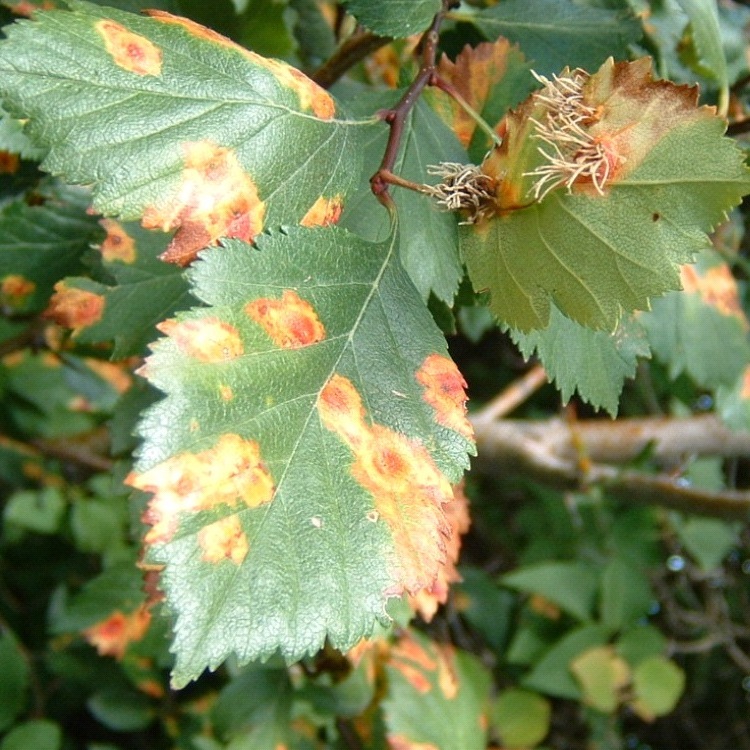
Phloxes can also be attacked by the following pests:
Nematode.

Thrips.

Caterpillars.

Slobbering penny.

For pest control, the drug Actellik is used, which should be sprayed on the aerial part of phlox. It is also advisable to water the flower with Aktara's solution. It is impossible to get rid of nematodes and the diseased plant will have to be disposed of. In the place where it grew, it is recommended to grow marigolds for 3 years.
Subject to all the recommendations for planting and further care, phloxes will delight with abundant flowering for 15 years.

